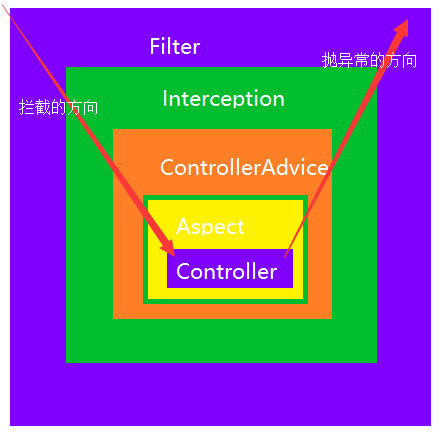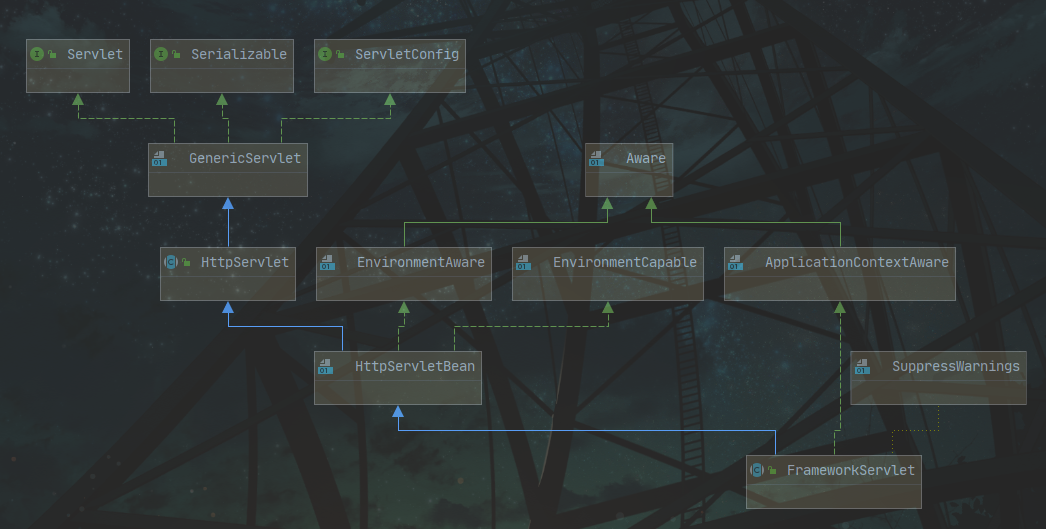AOP
谈到AOP,我们要清楚,AOP指的是面向切面的设计思想,而SpringAOP是AOP思想的一种具体实现,除此之外,常用到的还有AspectJAOP,两者的区别主要有:
织入的时期不同
Spring Aop采用的动态织入,而Aspectj是静态织入。静态织入:指在编译时期就织入,即:编译出来的class文件,字节码就已经被织入了。动态织入又分静动两种,静则指织入过程只在第一次调用时执行;动则指根据代码动态运行的中间状态来决定如何操作
可以应用的对象不同
Spring AOP的通知是基于该对象是SpringBean对象才可以,而AspectJ可以在任何Java对象上应用通知。
在初学AOP时,我曾将Filter、Interceptor和SpringAOP混淆不清,而这些其实都是AOP思想的一些具体的实现,根据具体情景选择不同的实现即可
Filter类似于JavaWeb中我们手动配置的过滤器,在Spring中实现javax.servlet下的Filter接口将其作为一个Bean注入到IOC容器中使用,实现doFilter方法即可
Interceptor是Spring自带的拦截器,实现HandlerInterceptor并实现preHandle、postHandle、afterCompletion方法就可以使用
使用SpringAOP,需要标注
@Aspect注解,指明切面类和方法,这里给出一个具体实例1
2
3
4<dependency>
<groupId>org.springframework.boot</groupId>
<artifactId>spring-boot-starter-aop</artifactId>
</dependency>1
2
3
4
5
6
7
8
9
10
11
12
13
14
15
16
17
18
19
20
21
22
23
24
25
26
27
28
29
30
31
32
33
34
35
36
37
38
39
40
41
42
43
44
45
46
47
48
49
50
51
52
53
54
55
56
public class LogAspect {
//定义切面,其他方法直接引用这个方法作为切面
public void webLog(){}
/**
* 通过RequestContextHolder可以获取到请求上下文信息
* @param joinPoint
*/
public void deBefore(JoinPoint joinPoint) {
// 接收到请求,记录请求内容
ServletRequestAttributes attributes = (ServletRequestAttributes) RequestContextHolder.getRequestAttributes();
HttpServletRequest request = attributes.getRequest();
// 记录下请求内容
System.out.println("URL : " + request.getRequestURL().toString());
System.out.println("HTTP_METHOD : " + request.getMethod());
System.out.println("IP : " + request.getRemoteAddr());
System.out.println("CLASS_METHOD : " + joinPoint.getSignature().getDeclaringTypeName() + "." + joinPoint.getSignature().getName());
System.out.println("ARGS : " + Arrays.toString(joinPoint.getArgs()));
}
public void doAfterReturning(Object ret) {
// 处理完请求,返回内容
System.out.println("方法的返回值 : " + ret);
}
//后置异常通知
public void throwsE(JoinPoint jp){
System.out.println("方法异常时执行.....");
}
//后置最终通知,final增强,不管是抛出异常或者正常退出都会执行
public void after(JoinPoint jp){
System.out.println("方法最后执行.....");
}
//环绕通知,环绕增强,相当于MethodInterceptor
public Object arround(ProceedingJoinPoint pjp) {
System.out.println("方法环绕start.....");
try {
Object o = pjp.proceed();
System.out.println("方法环绕proceed,结果是 :" + o);
return o;
} catch (Throwable e) {
e.printStackTrace();
return null;
}
}
}

推荐一篇文章详细介绍了三者的用法:Filter,Interceptor和SpringAop - 爱跑步的星仔 - 博客园 (cnblogs.com)
RequestContextHolder
为了方便我们在任何方法中都能快速获取请求相关信息,SpringMVC封装了RequestContextHolder来帮助我们快速获取Request,在调用业务时就不需要将Request作为参数传入
基本使用
1 | //在没有使用JSF的项目中这两个方法是等效的 |
在使用时会想到几个问题:
- RequestContextHolder是如何与当前请求绑定的?
- request和response何时被设置进去?
- 为什么RequestAttributes强转ServletRequestAttributes之后可以直接获取请求和响应?
RequestContextHolder中封装了两个ThreadLocal保存当前请求和请求参数,对当前请求进行绑定
1
2private static final ThreadLocal<RequestAttributes> requestAttributesHolder = new NamedThreadLocal("Request attributes");
private static final ThreadLocal<RequestAttributes> inheritableRequestAttributesHolder = new NamedInheritableThreadLocal("Request context");在接收请求的过程中,会进行HttpServletBean的初始化,最终调用到FrameworkServlet实现的对应方法,FrameworkServlet的相关依赖如图

这里我们来看processRequest方法
1
2
3
4
5
6
7
8
9
10
11
12
13
14
15
16
17
18
19
20
21
22
23
24
25
26
27
28
29
30
31
32
33
34
35
36
37
38
39
40
41
42
43protected final void processRequest(HttpServletRequest request, HttpServletResponse response)
throws ServletException, IOException {
long startTime = System.currentTimeMillis();
Throwable failureCause = null;
//获取上一个请求的LocaleContext
LocaleContext previousLocaleContext = LocaleContextHolder.getLocaleContext();
//建立新的LocaleContext
LocaleContext localeContext = buildLocaleContext(request);
//获取上一个请求的RequestAttributes
RequestAttributes previousAttributes = RequestContextHolder.getRequestAttributes();
//建立新的RequestAttributes
ServletRequestAttributes requestAttributes = buildRequestAttributes(request, response, previousAttributes);
WebAsyncManager asyncManager = WebAsyncUtils.getAsyncManager(request);
asyncManager.registerCallableInterceptor(FrameworkServlet.class.getName(), new RequestBindingInterceptor());
//初始化LocaleContextHolder和RequestContextHolder
initContextHolders(request, localeContext, requestAttributes);
try {
//调用子类的doService方法
doService(request, response);
}
catch (ServletException | IOException ex) {
failureCause = ex;
throw ex;
}
catch (Throwable ex) {
failureCause = ex;
throw new NestedServletException("Request processing failed", ex);
}
finally {
//恢复request
resetContextHolders(request, previousLocaleContext, previousAttributes);
if (requestAttributes != null) {
requestAttributes.requestCompleted();
}
logResult(request, response, failureCause, asyncManager);
//发布事件
publishRequestHandledEvent(request, response, startTime, failureCause);
}
}至此对每个请求的RequestContextHolder进行了封装
在buildRequestAttributes方法中返回了新的ServletRequestAttributes对象,这个类继承了RequestAttributes,拥有更多的方法
1
2
3
4
5
6
7
8
9
10
11
protected ServletRequestAttributes buildRequestAttributes(HttpServletRequest request,
HttpServletResponse response, RequestAttributes previousAttributes) {
if (previousAttributes == null || previousAttributes instanceof ServletRequestAttributes) {
return new ServletRequestAttributes(request, response);
}
else {
return null; // preserve the pre-bound RequestAttributes instance
}
}